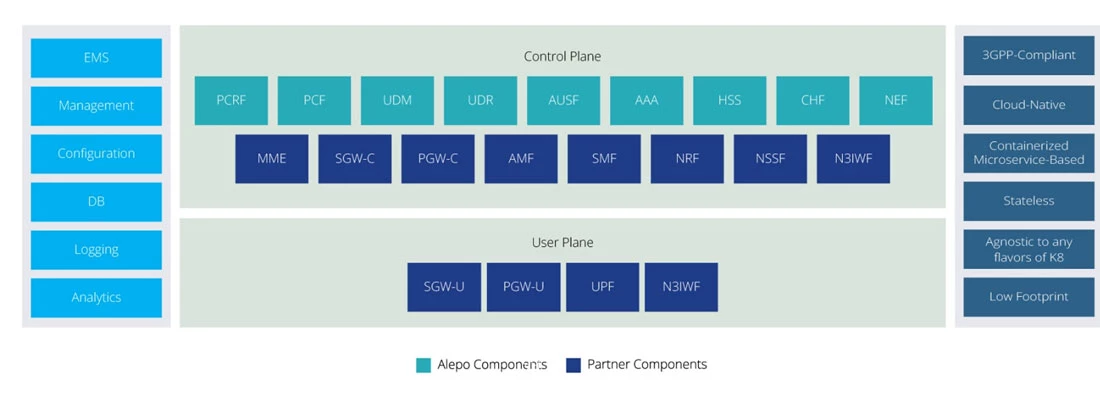Top ways for operators to accelerate their 5G rollout
by Alepo Technologies Inc Digital enablement and revenue management software5G rollout will open new opportunities
Operator challenges in launching 5G
5G technology has made significant progress on several fronts over the last few years. There are more 5G-compatible devices in the market like the iPhone 12 and home routers. Wireless RAN infrastructure and cloud technologies have been developed to support next-gen capabilities. And the foundation for a potentially rich business ecosystem of partnerships is also emerging. But adoption is still in the nascent stage.
Operators today have a host of concerns in transitioning their networks to 5G, which include:
- Reluctance to make the massive investment required for wide 5G coverage.
- Lack of spectrum availability in many regions and local regulatory challenges.
- Low prevalence of 5G devices, meaning operators may not be able to upsell consumers.
- Technical complications in implementing 5G alongside an existing LTE network, as it would lead to complex network infrastructure that presents difficulties in management and high maintenance costs.
How operators can swiftly launch 5G
Using a combination of mid-band and low-band spectrum
While multi-gigabit 5G speeds are seen only on high-band spectrum (mmWave), many operators have proven success in using sub-6 spectrum in low bands and mid bands for a 5G launch on a wider scale. Using a combination of spectrum in low bands and mid bands also promises larger geographical coverage with higher bandwidth. This approach will result in a balanced 5G network that is faster than 4G, ensuring the best performance indoors and outdoors.
Following a two-phase NSA approach
Technically called the eUTRA-NR Dual Connectivity (EN-DC) approach, this will allow operators to reuse and leverage their existing resources, keeping the promise of 5G intact. The 5G radio (gNodeB) can connect to the EPC (the LTE core), enabling implementation of a 5G Non-Standalone (NSA) deployment. This approach will immediately enable the enhanced mobile broadband (eMBB) use case. Voice calls will be sent over the 4G network using EPS fallback.
Issue eSIMs instead of physical SIM cards
eSIM or embedded SIM is the electronic form of a physical SIM card. eSIMs are mounted permanently to a device. A user can digitally add plans from cellular operators to their eSIM without having to physically replace the SIM card. The eSIM not only improves design flexibility, it also allows the operator to digitally distribute subscriptions in bulk. It will enable faster time-to-market for operators, as a 5G eSIM can be simply delivered in the form of a QR code via email, making it much easier to distribute than physical SIMs.
Most major operators now support eSIMs. The number of mobile devices that support them is steadily growing, and will soon be far more widespread.
Prioritize network virtualization
Arguably the best thing about 5G is its cloud-native architecture. A virtualized 5G RAN and core can reside on generic commercial off-the-shelf (COTS) hardware, eliminating dependence on proprietary hardware vendors. This approach is much more flexible and cost-efficient as it will allow operators to scale up hardware resources with increasing user traffic. A 4G virtualized RAN can enable 5G with only a software update. Enhancements to network functions can be delivered via software patches. Operators will benefit significantly from virtualizing their 4G networks on priority, as it will enable a hassle-free, easier, faster 5G rollout.
Begin with private 5G networks
Private 5G is a dedicated and standalone next-gen cellular network best suitable for relatively smaller and more confined areas like universities, airports, campuses, buildings, and more. This private network can be launched in a matter of weeks with a limited resource footprint. It provides higher bandwidth to enable all 5G business use cases over a secure and private connection for different Industry 4.0 applications. A specialized compact core makes the installation easier and faster.
Enabling private 5G networks for enterprise clients is the best fit for operators who want to soft launch a real-world 5G network on a smaller scale before moving forward with a more large-scale launch.
Forge partnerships to improve the device ecosystem
Even though 5G launches are rapidly progressing around the world, the device ecosystem is still limited. Though most of the mid-range smartphones launched in 2021 support 5G, many users still need to upgrade their existing devices to experience 5G. What operators can do here is partner with OEMs to offer 5G mobile phones and Mi-Fi devices at a subsidized price to drive consumer interest. Trade-in programs will also help. This will enable operators to gain major traction for a faster 5G rollout and drive competition around the market.
Conclusion
With its cloud-first architecture, high bandwidth, and low latency, 5G has been emerging as a platform that will drive innovation in various sectors like healthcare, automobiles, logistics, massive IoT, and more. Industrial IoT and mission-critical use cases will benefit from the always-on and real-time connectivity of this next-gen network.
Early 5G rollout will give operators more time and opportunities to explore new use cases. In an increasingly competitive and dynamically changing market, the first-mover advantage is key.
Alepo’s industry-leading 5G Core solutions enable swift and easy deployment, provide a low resource footprint, and ensure standards-compliant infrastructure for a scalable and future-proof network. They enable operators to generate more revenue from avenues that were previously unexplored in telecom. Partnering with leading technology partners, Alepo delivers end-to-end 5G solutions that have enabled commercial success for over a dozen real-world deployments globally.

Alepo’s 5G Core Network Architecture
To begin your next-gen journey today, email us at market.development@alepo.com.
Sponsor Ads
Created on Sep 21st 2022 06:59. Viewed 122 times.



